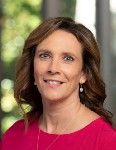Shortly after he became president of the Claremont School of Theology in 2000, the Rev. Philip Amerson approached the altar to receive the Eucharist at a Sunday worship service.
Instead of saying, “the body of Christ” as he handed bread to Amerson, the Eucharistic minister asked, “Can I see you afterwards? I’ve had a thought about something at school.”
It was what Amerson called a “confirming moment:” Work was so overwhelming he wasn’t even safe from it in his home congregation.
An ordained United Methodist minister, Amerson was an accomplished research professor with 21 years of pastoral experience when he moved with his wife and two children to California. He thought he’d have a smooth transition. But the new expectations and pressures of the job quickly mounted.
Questions to consider
Questions to consider on this topic:
- When have you reached out to others to help you make transitions or to help you discern? When is the right time to ask for help?
- How have you surrounded yourself with others who “can sing very well” in your professional life? When have you not done so and felt the lack?
- In your own experience of transitions, when have you felt a real tension between chronos and kairos time?
- What do you know of being the one to “carry both the organization’s possibility and its sin”?
“One of the challenges of jobs like this is that you can never get away from it,” said Amerson, who is now president of Garrett-Evangelical Theological Seminary in Evanston, Ill. “The joy is that it’s something new every day, you’re learning every day. That’s the upside.
“The downside is realizing that you had to go to the bathroom two hours ago, and there hasn’t been a moment for you just to walk across the room or down the hall and handle something as basic as that ... I wasn’t eating like I should. I wasn’t exercising like I should, and I wasn’t praying like I should.”
Professionals taking on a new job -- especially one involving a significant increase in responsibility -- feel the intense pressure to start well. Like President Barack Obama, most leaders find that every action they take in the first 100 days is intensely scrutinized, and signals to others how they will lead.
To smooth the adjustment, new leaders should move carefully in the first days. Experts and leaders who have made major transitions recommend they assess their new landscape; create a plan of action in collaboration with others; seek personal and professional support; and expect to feel overwhelmed.
The Rev. Timothy Shapiro, president of the Indianapolis Center for Congregations, said most people don’t change jobs often enough to get good at it. So it’s hard to get it right.
“The leader is the carrier of both the possibility and the sin of the organization,” Shapiro said. “No job description says that the leader is responsible for the dirty knowledge of the institution and the vessel for that which is unsolved, unredeemed and just plain wrong about the place.
“But that is the reality. So, during the first 100 days, a primary spiritual task is working out with God how one is going to tolerate these uncomfortable realities.”
Journey into darkness
In many ways, a new job is a journey into the darkness. Coming from a parish setting, for example, Amerson didn’t realize the magnitude of the learning curve he faced as CEO of a complex institution.
Even small details could be confounding: Early in his tenure, Amerson’s secretary told him she needed information for the IPEDS, the acronym for the data collection program used by all postsecondary educational institutions. Amerson had never heard of it.
He grappled with multiple constituencies and a more complex budgeting and auditing system. Dozens of such experiences stretched Amerson to the breaking point.
“I wasn’t sleeping,” he said. “I would be up almost every night in the middle of the night. I was over-functioning in terms of reading everything and not reading the right thing, and I didn’t know where to make the distinction about what was most important.”
Part of the reason transitions can be unexpectedly difficult is that people feel confident that they’re good at what they do -- after all, that’s why they have this new job. Becoming a beginner again can be humbling, especially if one’s experience isn’t directly related to the new task.
When the Rev. Arnetta Beverly moved from the parish to a conference staff position, she wasn’t prepared. In the parish, she had handled the flow of information that came from the conference to the local church, but she had no sense of how it was generated.
“I think I would have been better prepared had someone guided me,” Beverly said.
Later, when she became the first black female United Methodist superintendent in the Western North Carolina Conference, the move was more seamless. Beverly now is pastor of St. Matthew United Methodist Church in Greensboro, N.C.
And, in addition to the work demands, people in transition often struggle with the emotional shift as they say goodbye to one identity and embrace another.
“The measure of 100 days…is concrete; it is chronos time, sequential and quantitative. But it is too early for this way of thinking,” said Shapiro, a Presbyterian whose organization offers support to congregations in Indiana. “One’s heart and soul is very much in a kairos state, a time beyond time with much leave-taking and even grief.”
The Rev. Mike Ehmer, managing director of the national Fresh Start Program of the Episcopal Church, which offers resources and guidance for clergy and congregations in transition, says new leaders should be attentive to the inner shifts as well as the work duties.
“You can move from city to city, but that doesn’t mean you have transition,” he said. “In sacramental terms we talk about change being the outward and visible sign, whereas the transition is more of the inward process, the emotions, the psychological framework, the mental outlook and the spirituality of the change.”
Transitions, which can last one to two years, can be frightening, Ehmer said. “Before that trapeze artist can grab hold of that new [bar], they’ve got to let go of the other one, and guess what? For a little bit of time you’re out there in Nowhere Land, floating with nothing.”
By what authority?
New leaders may feel they’re floating, but at the same time they must settle into their new authority role, Shapiro said, noting that many in parish ministry are ambivalent about power.
“During the early days, it is too early to exercise much of the power -- unless the organization is at risk or in crisis,” Shapiro said. “But it is not too early to learn to hold the power.”
The most appropriate way to wield power may change from institution to institution, and what worked in a previous job might not work in a new one.
Charlotte businessman C.D. Spangler said he found that the approach he used in the business world with great success simply did not work when he became president of the University of North Carolina system in 1986.
As the CEO of corporations in several industries, including construction, motels and banking, Spangler took advice from his vice presidents, but the final decisions were his. Once he made a call, the people who worked for him did exactly what he wanted.
In an academic setting, with deans, faculty and the board of governors to satisfy, Spangler said persuasion worked better. “It is not a command situation,” he said.
For Spangler, a charter member of Charlotte’s Myers Park Baptist Church, one of the key lessons about forming a team came from the childhood experience of singing in the church choir.
“Several of the boys had good voices; I didn't….We’d come out after church and be there all gathered around, and the people would come up to me and say what a good voice I had,” he said. “Well, I knew I didn’t have a good voice, but I thanked them. And my mother and daddy were standing there; they were proud of me.
“I learned at an early age that if you’re going to have to be part of choir, make sure that everybody else around you knows how to sing.”
The Rev. Edwin Aponte, the Presbyterian dean of Lancaster Theological Seminary, also avoided the command approach when he began as dean in 2006. He wanted to show right away he was a team player. He told staff he wanted to reach decisions through consensus rather than “by the dean’s fiat.”
“I very definitely wanted to show that I was going to be collaborative in my leadership,” he said. “Collaborative leadership in this context meant that I needed to get out of my office and visit faculty in their offices and be seen by students on the campus.”
Plan of action
The Rev. Robert H. Ramey, Jr., author of “The Pastor’s Start-up Manual,” says a new leader needs a plan, and the plan must be based on a depth of knowledge of his or her new environment -- its history, its workers, its mission.
Ramey and others suggest forming this plan in collaboration with others. Drawing upon the work of organizational psychologist Rensis Likert, Ramey said leaders in faith settings should be open to new ideas, work in teams, expect excellence and use group decision-making methods.
“You don’t come in to dazzle them with your footwork, so much as you come in to show them that you intend to lead by being a servant,” Ramey said. “That doesn’t mean that you don’t have an agenda that you would someday like to articulate, but you find out where they are first.”
When she began her new job as dean of Boston University School of Theology in January, the Rev. Mary Elizabeth Moore said she already had a plan. An ordained United Methodist deacon, Moore is the first woman to head BU’s theology school.
To aid her transition, Moore began meeting with school officials last summer, including the selection committee, the provost, the outgoing dean and other faculty and staff. She’s continuing that practice as she enters her first 100 days.
She plans to meet with each faculty member in the first month to learn about their vision and figure out how the school can support them, she said.
Seeking support from others -- and from God
For Amerson, the former Claremont president, the adjustment became too much to handle alone.
At the urging of his wife, Elaine, he went to a doctor, who said Amerson was overweight and his cholesterol was too high. To improve his health, he started taking early morning walks.
“During that time I would pray as I walked. That really was the renewal of my devotional life,” he said. “Even though a lot of the tough moments followed, that really was a trigger time for me to begin to get things back on track.”
He also asked for help. Amerson eventually hired an executive coach, an ordained United Methodist minister with experience in the business world. The pair met and spoke by phone over a three-year period that included the overlap between Amerson’s jobs at Claremont and at Garrett.
Ehmer suggests today’s faith-based leaders follow Jesus’ lead, especially in new and stressful situations. Jesus, he said, also sought time alone for prayer and thinking.
“Clergy are notoriously bad with boundaries,” Ehmer said. “They don’t know where to separate their family life or their personal life from their work life, so it all blends together. Clergy tend to be living in glass houses. There are some who can live that way, but others reach a breaking point and have a breakdown.”
In addition to her demanding new job, Moore has a demanding home life. The mother of five, she also cares for her chronically ill husband and has an adult daughter living at home. Moore said the people at BU have accepted her and her family as “whole people.”
“They know that I’m going to work as hard as I possibly can for and with them, but they also know that I care deeply for my family,” she said. “This is part of who I am and I’ve learned to balance it over the years.”
‘A moment of release’
For Amerson, taking the reins at Garrett allowed him another chance at a first impression. He believes he did a good job at Claremont, despite the rough start, but when he became president at Garrett, he drew on his earlier experience. Feeling he had been too tentative at Claremont, he formed a 12-person transition team and within three months had developed seven strategic goals for the school.
Today, Amerson no longer uses an executive coach. He’s healthier, sleeps better and prays more. A second “confirming moment” came when a board member invited Amerson on a hike in the Grand Canyon. After the hike, Amerson rested on a swing, exhausted but happy. Recently he posted a photo of that moment on his Facebook site.
“I realized that image [captured] a sense of great relief,” he said. “I had made it out and survived.”












